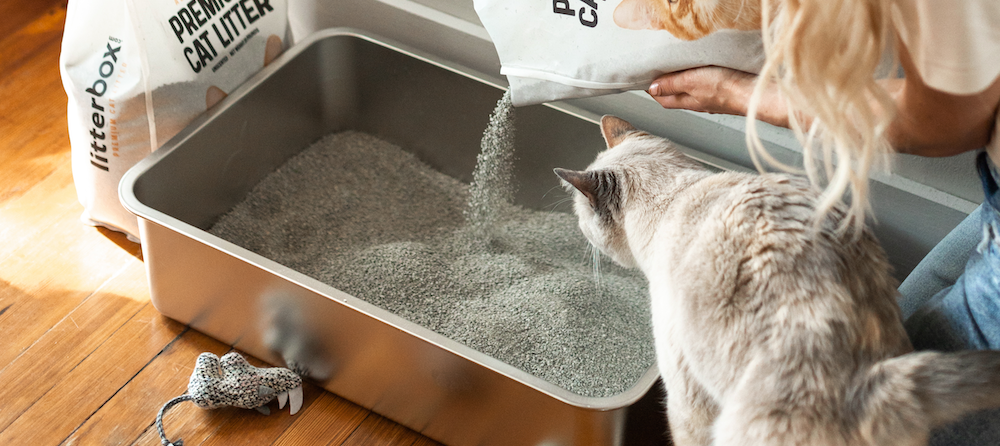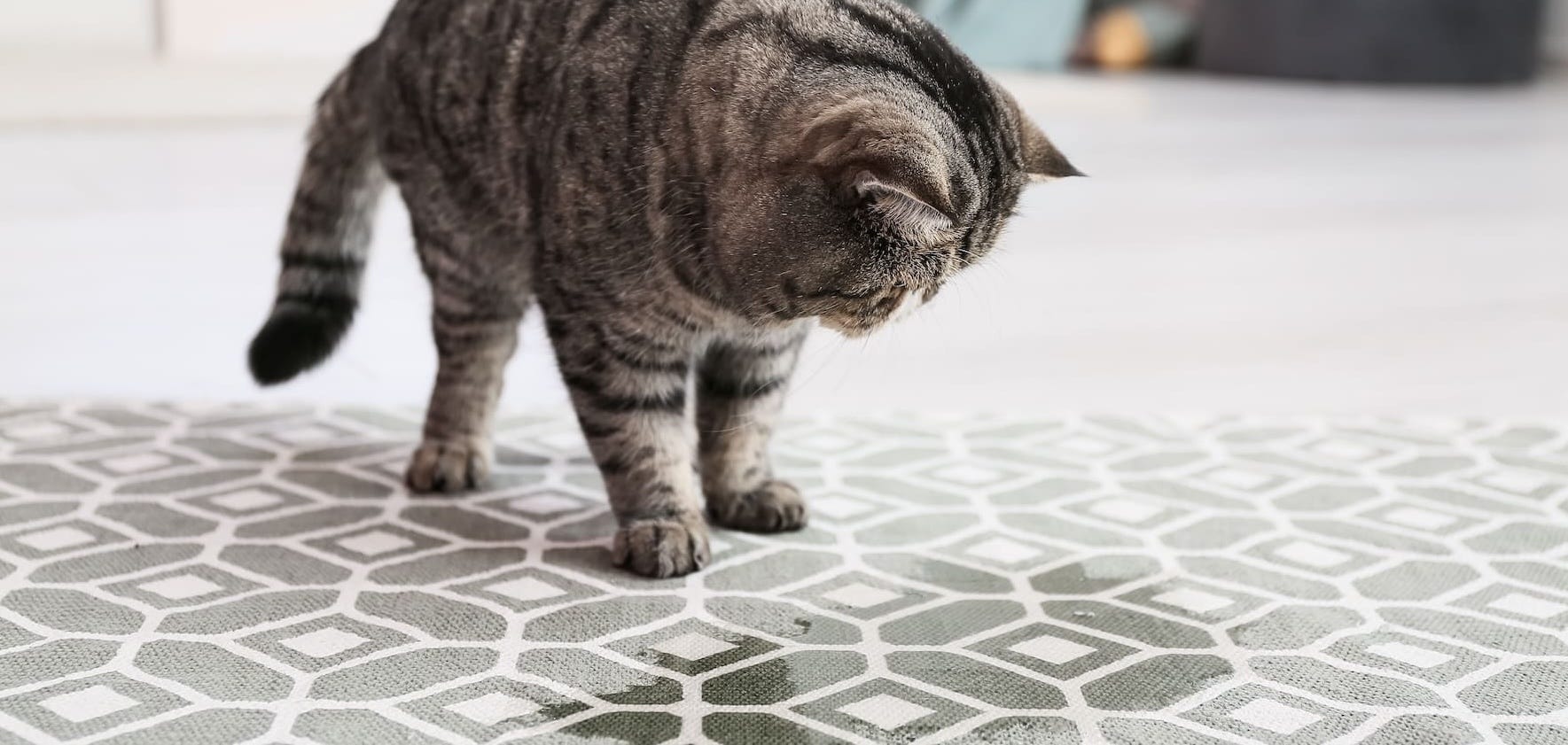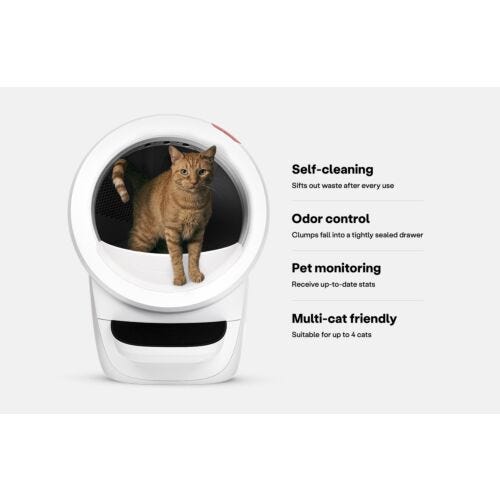Life with cats often feels like a revolving door of cleaning tasks: vacuum the fur here, scoop the litter box there, clean the vomit here, sweep the cat litter there—and so on. The prospect of so many daily chores is as overwhelming as an epic spring cleaning spree.
First, take a deep breath. Then, keep reading to learn how to accomplish these cat cleaning tasks efficiently yet effectively.
General cleaning tips
Although cleaning up after your cat is certainly a chore, it doesn’t have to be a difficult one. Learn how to choose a pet-friendly cleaner, remove cat hair from your home, and create cat-free zones in our general cleaning tips below.

Pet-safe cleaning products
Your first priority is to choose a cleaning product that’s safe for pets (and, of course, humans). If your cat walks on or licks an area that was recently treated, you can rest easy knowing you’ve used a product that won’t sicken them.
The best pet-safe cleaning products tend to be fragrance-free. Avoid cleaning products that use any of the following ingredients:
- Ammonia
- Bleach
- Chlorine
- Essentials oils, particularly tea tree
- Formaldehyde
- Phenols
- Phthalates
- Rubbing alcohol
Try a DIY pet-safe cleaner like vinegar, baking soda, and water (or any combination thereof). Follow instructions on product packaging for proper dilution.
Enzymatic cleaners like Cleaner Spray or Cleaner Wipes by Whisker are pet-safe and available for subscription. Not only are these products fragrance-free, they are specifically formulated for pet messes. Their bio-enzymatic technology utilizes non-pathogenic (“good”) bacteria to digest organic material, stains, and odors caused by urine, feces, vomit, and saliva.
Even when using pet-safe cleaners, make sure the treated area dries completely before allowing your pet access.
Cat hair removal
Fur-covered surfaces and errant clumps of hair are ubiquitous in a pet home, especially if you have multiple cats. Come spring and summer, you may feel as if your interior has literally grown a fur coat. What’s a cat parent to do with those tumbleweeds of hair and furniture that sheds as badly as cats themselves?
The key to staying on top of cat hair removal is consistency.
- Vacuum daily: Carve out 10 minutes every day to vacuum the areas your cat most frequently sleeps or grooms themselves. You may want to invest in a vacuum specifically designed for pet homes or a robot vacuum that cleans throughout the day.
- Use a lint roller or similar device: A pet hair remover tool can be used on trickier areas, such as stairs, upholstered furniture, and bedding. Some rollers create a hair-grabbing electrostatic charge, while others use sticky adhesive to pick up fur.
- Try an air purifier: A high-quality air purifier will trap contaminants such as pet hair and dander. Some even feature pet-specific air filters.
Most importantly, brush your cat at least weekly, if not daily. Brushing your cat will help control the amount of fur released around your home, minimize ensuing hairballs, and create a lovely bonding session between you and your fur baby!

Cat-free zones
Limiting your cat’s access to certain areas of the home may help you stay on top of cleaning.
For example, people with cat allergies often treat their bedroom as a “cat-free zone” by always keeping the door closed. Others make the basement off-limits to cats so that one level of the home is suitable for guests with allergies, and so on.
For obvious hygienic reasons, keeping your cat off kitchen countertops and tables is a good idea. One way to do this is with double-sided sticky tape: When your cat jumps on the table, their paws will stick a little to the tape. This sensation will deter most cats from jumping back up. You might also consider spritzing those areas with a (pet-safe) foul-tasting substance like bitter apple spray.
How to stop cat litter tracking
Every cat parent is familiar with the feeling of tiny litter granules stuck to the underside of their bare feet. To some, it is a nuisance; to others, a catastrophe. Fortunately, there are ways to mitigate litter tracking in your home.
Litter mats
If you’re wondering how to keep cat litter off the floor, start with a good litter mat. Choosing the best cat litter mat for you and your pet depends on a few factors, such as the type of litter you use and how messy your cat is.
Look for the following characteristics in a litter mat:
- Made with high-quality materials, such as mesh with waterproof properties
- Designed to fit snugly against your litter box
- Features litter-catching technology, such as the LitterTrap® Mat with a top mesh layer designed to capture litter granules
- Urine-resistant and easy to clean

Covered litter boxes
An enclosed or covered litter box can help prevent litter from being kicked or scattered outside the box, keeping the surrounding area cleaner. It’s also a great solution to keep odors at bay.
Litter-Robot is one example of a covered litter box that minimizes litter tracking, especially when you add accessories like the Litter-Robot 4 Shield for messy cats.
If you’re worried about transitioning your cat to a covered litter box, know that research demonstrates that cats generally don't care whether their litter box is covered or uncovered.
Low-tracking cat litter
Some types of cat litter are more likely to track, including clay cat litter. Litter made of silica gel beads or crystals is known for its low dust, but most cats prefer clay-clumping cat litter.
Look for a low-dust, low-tracking cat litter that ensures your house won’t be covered in residue; one example is GreatLitter®. Unlike classic clay-clumping litter, which is crushed up, dried in a kiln, and then crushed again, the slow sun-drying process of GreatLitter® ensures a low-dust cat litter that is better for both your cat and your home.
Strategic litter box placement
Where you place the litter box can make a big difference in how much litter gets tracked. For example, you may see more tracking if the litter box is placed on hard flooring rather than carpet. If the box is in a room with heavy foot traffic, you’ll also notice more escaped granules around the house.
If possible, choose a calm, private location for the litter box, such as a bathroom, guest bedroom, hallway closet, or inside a piece of litter box furniture. Not only will this help curb the spread of litter, it’ll provide a better atmosphere for your cat to do their business.
Managing litter box odors
Cleaning frequency, type of litter box and litter, and use of odor control products all contribute to effectively managing cat odors. Keep reading for tips and tricks on litter box odor control.
Odor control products
Many litter boxes utilize activated carbon filters for odor control. Carbon filters can effectively absorb odors when replaced regularly.
Odor eliminators like OdorTrap® Packs take things one step further. This technology uses a blend of natural plant oils to attract, attach to, and neutralize odor molecules. Plus, it’s free of phthalates, parabens, and alcohol—unlike typical pet odor eliminators that use harsh chemicals and fake perfumes.
The type of cat litter you use can also help reduce odors. Clay and silica gel are better for cat litter odor control, while corn, wheat, or paper-based litter and wood pellets are not. Many cat parents turn to scented cat litter, which merely masks odors instead of reducing them. Furthermore, research on scented vs. unscented litter shows a potential association between scented litter and house-soiling behavior in cats.

Cleaning the litter box frequently
One surefire way to manage cat odors is to clean the litter box frequently. That includes scooping daily, changing the litter every 2-4 weeks, and cleaning the litter box itself with an enzyme cleaner whenever you notice odors building up.
Follow these tips for how to clean a litter box:
- Wear gloves
- Use a well-designed scoop
- Clean with an unscented, pet-friendly cleaner
- Avoid harsh chemicals
When it comes time to replace the litter in the box, you might wonder how much cat litter to use. Typically, cats prefer 2-3 inches of litter when using a standard litter box. Cats that like to dig around for a while to find the right spot may appreciate 3-4 inches.
Be sure to dispose of cat waste promptly—and don’t use cat poop for composting edible crops.
Getting the right cat litter box
The choice of litter box can make all the difference regarding pet odors. The best cat litter box for odor control is designed to minimize waste exposure and maximize odor-absorbing components. Choose a litter box with some or all of the following characteristics:
- Enclosed or covered design
- Odor-absorbing components like carbon filters
- Automatic and self-cleaning
- Compartment or drawer for disposed waste
- Easy to clean
Avoid these characteristics in a litter box:
- Open design
- Plastic material
- Small size
- Improperly sealed waste compartment
It’s also a good idea to avoid disposable litter boxes. Disposable litter boxes are generally constructed of paper and other recycled materials, which can be degraded by a cat’s urine content. This leads to strong smells of ammonia that can’t be removed until the box is discarded.
A self-cleaning litter box like Litter-Robot 4 offers unmatched odor control: It disposes of waste within minutes; features a tightly sealed, carbon-filtered waste drawer to trap odors; has a partially enclosed design; and is easy to clean.
Handling accidents
Cleaning cat pee and vomit is by far the least pleasant part of having a feline. It’s important to tackle accidents as soon as you notice them. Smells and stains can be a huge turn-off—not only for you and your family but for visitors as well. Remove cat urine or vomit using an enzyme cleaner to rapidly treat any spots where your cat has had an accident.

Cat urine cleanup
If your cat has ever peed or sprayed in your house, you know how difficult it can be to remove those harsh odors from carpets or furniture. Cat pee smells so bad because it is very concentrated and releases the stench of ammonia as it breaks down.
If your cat is having accidents, you first must address how to stop your cat from peeing everywhere. Common causes of this unwanted behavior include health issues (such as urinary infections), territorial marking, changes in routine or environment, a dirty litter box, and more. Depending on the cause, you can work toward a solution by taking your cat to the vet, minimizing stress for your cat, and cleaning the litter box more frequently.
But how do you get rid of cat urine smell from your whole house? First, identify the soiled spots; common locations include:
- Corners of rooms
- Upholstered furniture
- Rugs and carpets
- Potted plants
- Laundry
- Personal belongings
- Empty boxes
Next, gather an old towel and enzyme cleaner. Enzymatic cleaners are effective cat urine removers because their specialized enzymes target and break down the molecules responsible for cat urine smell. You can also make your own pet-safe DIY cat urine cleaner.
- Step 1: Absorb any wet urine with the old towel.
- Step 2: Apply the enzyme cleaner directly to the trouble spot and leave it to dry naturally, or wipe it up after 15 minutes. Do not rush the drying process.
- Step 3: Close off the room or use a laundry basket to cover the area that is being treated.
- Step 4: Keep airflow moving with fans and open windows to help odors escape your home.
The most important thing to remember is there is a root cause to your cat's behavior. Identify it to ensure that your cat stops urinating in the wrong places.
Cat vomit cleanup
Pet parents tend to tolerate their cats vomiting far better than their cats urinating outside the litter box—probably due to the lack of smell. The fact is, cat vomiting isn’t normal. If your cat is vomiting more than once or twice a month, it’s best to contact your veterinarian for an exam.
Cleaning up cat vomit is similar, if less intense, to cleaning up cat urine. Gather an old towel and enzymatic cleaner (which works just as well on vomit as it does urine) or your pet-safe DIY cleaner.
- Step 1: Wipe up any vomit with the old towel.
- Step 2: Apply the enzyme cleaner directly to the stain and leave it to dry naturally, or wipe it up after 15 minutes. Do not rush the drying process.
- Step 3: Close off the room or use a laundry basket to cover the area that is being treated.
We hope you’ll get the most out of these cat cleaning tips!









